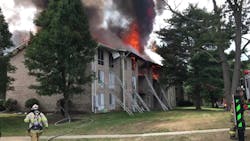On the Job: Maryland – Trench Cut Prevents Major Loss
Just prior to 1 p.m. on July 27, 2018, Public Safety Communications (PSC) received numerous 9-1-1 calls for a report of fire coming from the third floor of an apartment building in the 9000 block of Breezewood Terrace in Greenbelt, MD. This location is well known for the propensity of fire anywhere in the building to extend vertically into a common attic. PSC advised responding units from Prince George’s County of the multiple calls, and crews were able to see a large column of smoke as they approached the scene.
The building address was identified as 9004 Breezewood Terrace. The building is a three-story, ordinary-constructed garden-style apartment building with a peaked roof, and the address is the “end-of-the-group” building in a row of three attached structures. All are of the same construction and size, each separated by a masonry fire separation that extends to the underside of the roof deck. The complex was constructed in the early 1960s and consists mainly of similar garden-style apartments. Fire protection in the buildings consist of 120-V pull-stations with local smoke detectors in each unit. There is no automatic fire suppression/sprinkler system in the individual apartments.
Initial operations
The first-arriving engine, Greenbelt Engine 835, entered the complex and laid a 3-inch supply line from a nearby hydrant and reported a working fire at that time. The officer decided to continue their forward lay beyond the fire building. The crew stretched a 400 foot 1¾-inch attack line to the front side of the structure and advanced to the top floor to begin an interior attack.
The first-arriving ladder truck, Berwyn Heights Truck 814, arrived after Engine 835, and took a position at the front of the fire building. The officer gave a size-up of a three-story garden-style apartment with fire through the roof, immediately requested a second alarm, and established the tactical command. Truck 814’s interior crew proceeded to the third floor (top floor) where they found apartment 303 fully involved. They completed a primary search of the other three apartments on the third floor while waiting on the initial attack line.
Volunteer Chief 812A, College Park 812, established the command and positioned on the opposite side of the street with a clear view of the front side of the fire building and attached exposures. Command reported heavy fire through the roof and assigned Truck 814 as the Division 3 supervisor, with Engines 835 and 812B under his supervision, to begin an interior attack while also ordering Truck 814’s outside crew to begin a trench cut between 9002 and the main fire building of 9004 Breezewood Terrace.
Past history of fighting fires within this complex reveals that a fire on any level of the structure will extend horizontally and then, once in the attic area, will extend rapidly into attached structures. It is not uncommon for a significant fire within one apartment building to result in the loss of all attached buildings. As such, it is imperative to get a quick stop, get a charged hoseline on the top level and open all concealed spaces to reveal the path of extension. During this fire, the incident commander (IC) requested a trench cut early in the incident to prevent extension to the attached building, relieve any built-up interior heat and smoke, and allow the crews operating attack lines a better environment to operate.
Engine 812B picked up the first-due engine’s supply line and secured the water supply for Engine 835. The crew proceeded up the block to the engine, where they advanced a second attack line from Engine 835 around the front entrance to the top floor of the building and assisted with the fire attack. The attack line was made up of a “leader-line” setup, utilizing a 3-inch line to a gated wye, extended with a 1¾-inch standpipe rack for a 300–350-foot stretch.
As additional initial- and second-alarm units arrived, ladder trucks set up for master streams with engine companies laying from larger water main hydrants to the ladder trucks. Within a short period of time, interior attack crews were removed, with ladder pipes going into operation. After the bulk of the fire was knocked down, interior crews re-entered the building to complete extinguishment.
There were approximately 80 firefighters and medics on the scene of this incident, including mutual-aid response from the Montgomery County Department of Fire and Rescue Services. The fire caused an estimated $250,000 in fire loss and, fortunately, there were no firefighter or civilian injuries.
Key takeaway
A trench cut applied early in the incident near the split of the two buildings prevented the fire from spreading into the adjoining structure. Ultimately, ordering a trench cut provides a “choke point” or helps “draw a line in the sand,” so to speak, so fire will not extend pass this point.
Coordinated actions between the roof/ventilation crew and the personnel operating the attack line are necessary to protect everyone involved and to stop the fire extension at this point. In this case, the historical knowledge of fighting fire in these apartment buildings allowed the IC to make the right decision at the right time and held the fire to the building of origin.
About the Author
Mark Brady
Mark Brady is a 40-year member of the fire service, including 38 years with the Prince George’s County, MD, Fire/EMS Department. He has 23 years’ experience as chief spokesperson and PIO for the department.
